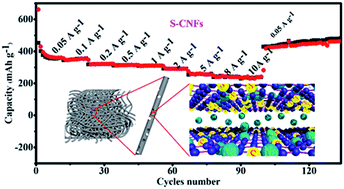Experimental design and theoretical calculation for sulfur-doped carbon nanofibers as a high performance sodium-ion battery anode†
Abstract
Hard carbon is one of the most promising anode materials for sodium ion batteries (SIBs) due to its low cost, high conductivity and suitable potential; however, its application is hindered by its relatively low capacity, and unsatisfactory rate capability and cyclability. Herein, we have reported a high performance SIB anode of S-doped interconnected carbon nanofibers (denoted as S-CNFs) that was directly derived from the industrial waste product bacterial cellulose, demonstrating great potential for practical application and sustainable development. The S-CNFs present high reversible capacities of 460 mA h g−1 at 0.05 A g−1 and 255 mA h g−1 at 10 A g−1, and preserved a capacity of 310 mA h g−1 at 1 A g−1 after 1100 cycles. Structural and electrochemical analyses revealed that multiple factors including the expanded (002) interlayer spacing, the electrochemically active –C–S–C– covalent bonds, the capacitive process induced by a large surface area and considerable defects as well as the stable structure associated with the cross-linked network contributed to their excellent performance. Furthermore, the first principles evaluations confirmed the sodium-storage mechanism of sulfur doping, which not only improved the interlayer distance for the mobility of Na+ but also promoted the electronegativity as well as the electrochemical activity and increased the adsorption of Na+.



 Please wait while we load your content...
Please wait while we load your content...